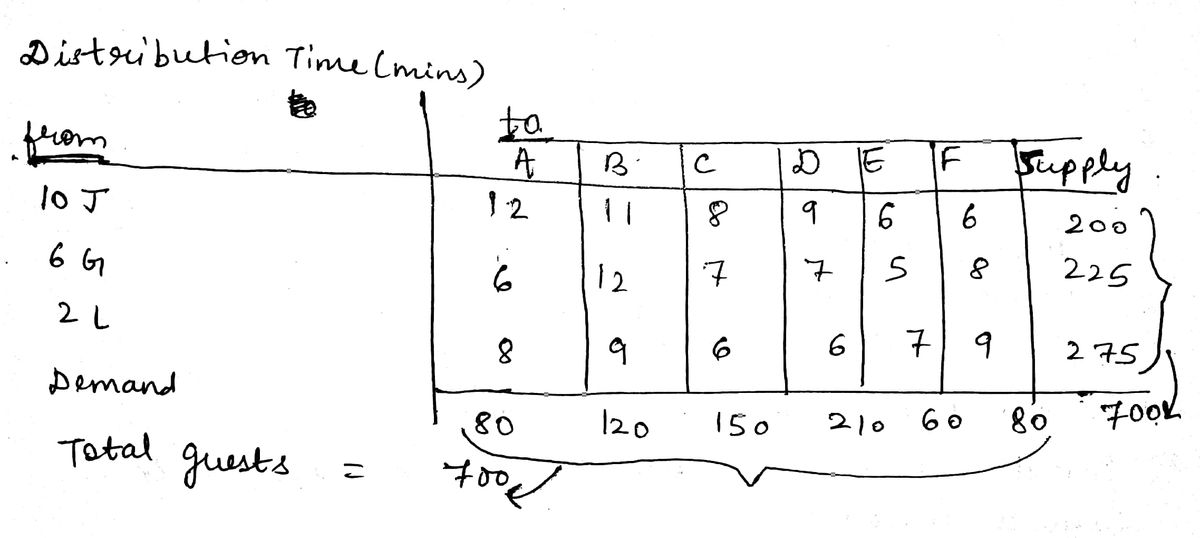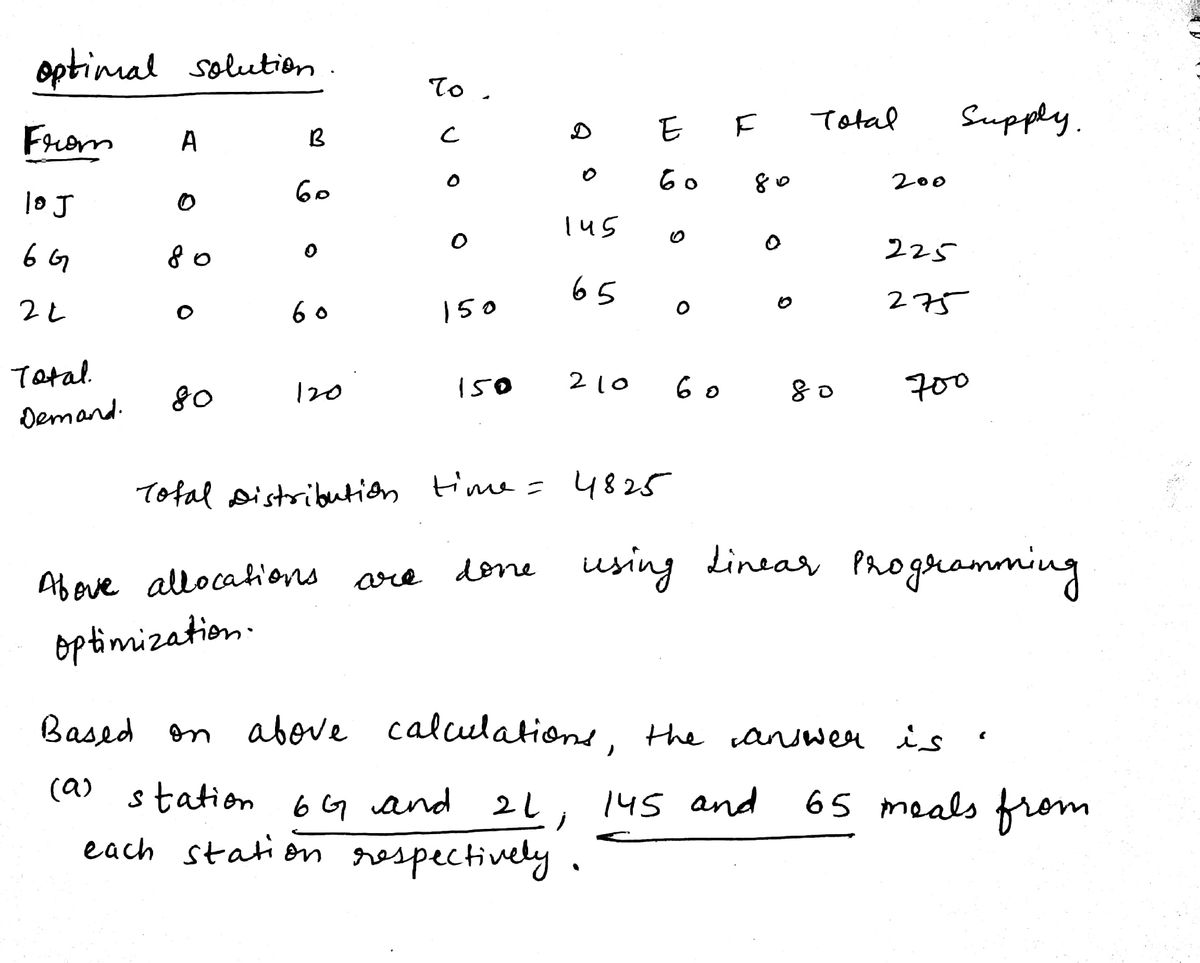In your optimal solution, where will section D get its meals, and how many from each station? Stations 6G and 2L, 145 and 65 meals from each station respectively. o Stations 6G and 2L, 150 and 60 meals, respectively from each station. o Stations 10J and 2L, 100 and 110 meals from each station respectively. o Station 10J and 6G, 145 and 65 meals from each station respectively.
In your optimal solution, where will section D get its meals, and how many from each station? Stations 6G and 2L, 145 and 65 meals from each station respectively. o Stations 6G and 2L, 150 and 60 meals, respectively from each station. o Stations 10J and 2L, 100 and 110 meals from each station respectively. o Station 10J and 6G, 145 and 65 meals from each station respectively.
Practical Management Science
6th Edition
ISBN:9781337406659
Author:WINSTON, Wayne L.
Publisher:WINSTON, Wayne L.
Chapter2: Introduction To Spreadsheet Modeling
Section: Chapter Questions
Problem 20P: Julie James is opening a lemonade stand. She believes the fixed cost per week of running the stand...
Related questions
Question

Transcribed Image Text:Casper Geriatric Center, a senior medical facility located in a large hospital in New
Zealand, started a procedure where their guests receive their meals in their rooms while
the food is still as hot as possible. The facility will continue to prepare the food in the
commissary, but will now deliver it in bulk (not individual servings) to one of three new
meal serving stations in the building. From there, the food will be reheated, meals will be
placed on individual trays, loaded onto a cart, and distributed to the various floors and
sections of the facility.
The three new serving stations are as efficiently located as possible to reach the various
hallways in the facility. The purpose of the new procedure is to increase the temperature
of the hot meals that the guest receives. Therefore, the amount of time needed to deliver a
tray from a serving station will determine the proper distribution of food from serving
station to section. The table below summarizes the time associated with each possible
distribution channel.
DISTRIBUTION TIME (minutes)
TO: DESTINATIONS
FROM:
Section A Section B Section C Section D Section E Section F
SOURCES
Station 10J
12
11
8
9
6
6
Station 6G
6
12
7
7
8
Station 2L
9.
6
7
9.
Station 10J can supply 200 meals. Station 6G can produce 225. The maximum that Station
2L can prepare is 275. This month, there are 700 guests in the facility, 30% are in Section
D, 160 are divided equally in Sections A and F, Section B has 120, Section C has 30 more
patients than Section B, and the rest are in Section E.
In your optimal solution, where will section D get its meals, and how many from each
station?
o Stations 6G and 2L, 145 and 65 meals from each station respectively.
O Stations 6G and 2L, 150 and 60 meals, respectively from each station.
o Stations 10J and 2L, 100 and 110 meals from each station respectively.
o Station 10J and 6G, 145 and 65 meals from each station respectively.
Expert Solution
Step 1
Step 1: 
Step 2

Step by step
Solved in 4 steps with 4 images

Knowledge Booster
Learn more about
Need a deep-dive on the concept behind this application? Look no further. Learn more about this topic, operations-management and related others by exploring similar questions and additional content below.Recommended textbooks for you

Practical Management Science
Operations Management
ISBN:
9781337406659
Author:
WINSTON, Wayne L.
Publisher:
Cengage,

Operations Management
Operations Management
ISBN:
9781259667473
Author:
William J Stevenson
Publisher:
McGraw-Hill Education

Operations and Supply Chain Management (Mcgraw-hi…
Operations Management
ISBN:
9781259666100
Author:
F. Robert Jacobs, Richard B Chase
Publisher:
McGraw-Hill Education

Practical Management Science
Operations Management
ISBN:
9781337406659
Author:
WINSTON, Wayne L.
Publisher:
Cengage,

Operations Management
Operations Management
ISBN:
9781259667473
Author:
William J Stevenson
Publisher:
McGraw-Hill Education

Operations and Supply Chain Management (Mcgraw-hi…
Operations Management
ISBN:
9781259666100
Author:
F. Robert Jacobs, Richard B Chase
Publisher:
McGraw-Hill Education


Purchasing and Supply Chain Management
Operations Management
ISBN:
9781285869681
Author:
Robert M. Monczka, Robert B. Handfield, Larry C. Giunipero, James L. Patterson
Publisher:
Cengage Learning

Production and Operations Analysis, Seventh Editi…
Operations Management
ISBN:
9781478623069
Author:
Steven Nahmias, Tava Lennon Olsen
Publisher:
Waveland Press, Inc.